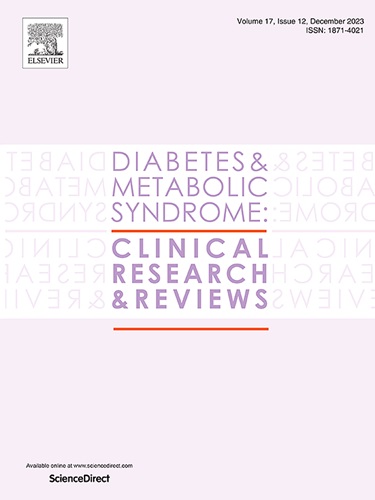解读全球成人2型糖尿病负担不成比例的风险因素格局:1990年至2050年的归因分析
IF 3.4
Q1 ENDOCRINOLOGY & METABOLISM
Diabetes & Metabolic Syndrome-Clinical Research & Reviews
Pub Date : 2025-01-01
DOI:10.1016/j.dsx.2024.103181
引用次数: 0
摘要
对全球2型糖尿病(T2D)亚人群风险因素影响的有限系统评估阻碍了有针对性的政策和资源分配。材料和方法:利用2019年全球疾病负担研究(GBD),我们分析了1990年至2019年全球成年人(25岁以上)中15种危险因素导致的T2D的残疾调整生命年(DALYs),并按性别、年龄、社会人口指数(SDI)和GBD地区进行了分析。此外,我们评估了到2050年这些风险因素的未来趋势。结果:2019年,高身体质量指数(BMI)成为所有亚人群的主要风险因素,预计到2050年,其影响将翻一番。1990年至2019年期间,吸烟对男性的影响更大,而二手烟和家庭空气污染对女性的影响更大。相关的DALYs随着年龄的增长而增加,除了高BMI和吸烟在60-74岁达到峰值。2019年,高SDI地区加工肉类含量高的饮食排名第二,与低SDI地区的家庭空气污染形成对比。观察到国家之间的差异,斐济在2019年与高BMI和饮食风险相关的伤残调整寿命率最高,分别比日本高约50倍和15倍。结论:针对每个亚群特定的主要危险因素进行量身定制的干预措施是全球抗击T2D成功的关键。本文章由计算机程序翻译,如有差异,请以英文原文为准。
Decoding the disproportionate risk factor landscape of global type 2 diabetes burden in adults: An attribution analysis from 1990 to 2050
Introduction
Limited systematic assessments of risk factor contributions to the global burden of type 2 diabetes (T2D) across subpopulations hinder targeted policies and resource allocation.
Materials and methods
Utilizing the Global Burden of Disease study (GBD) 2019, we analyzed the disability-adjusted life-years (DALYs) for T2D attributable to 15 risk factors in adults (aged 25+ years) globally and by sex, age, Socio-demographic Index (SDI), and GBD region, from 1990 to 2019. Additionally, we assessed future trends of these risk factors through 2050.
Results
High body-mass index (BMI) emerged as the predominant risk factor in all subpopulations in 2019, with its impact projected to double by 2050. During 1990–2019, males were more affected by smoking, while females by secondhand smoke and household air pollution. The related DALYs increased with age, except for high BMI and smoking peaking at 60–74 years. In 2019, diet high in processed meat ranked second in high SDI regions, contrasting with household air pollution in low SDI regions. National disparities were observed, with Fiji recording the highest rates of DALYs related to both high BMI and dietary risks in 2019, which were approximately 50 and 15 times higher than those observed in Japan, respectively.
Conclusions
Tailored interventions targeting major contributing risk factors specific to each subpopulation are key to the success of the global combat against T2D.
求助全文
通过发布文献求助,成功后即可免费获取论文全文。
去求助
来源期刊

Diabetes & Metabolic Syndrome-Clinical Research & Reviews
ENDOCRINOLOGY & METABOLISM-
CiteScore
22.90
自引率
2.00%
发文量
248
审稿时长
51 days
期刊介绍:
Diabetes and Metabolic Syndrome: Clinical Research and Reviews is the official journal of DiabetesIndia. It aims to provide a global platform for healthcare professionals, diabetes educators, and other stakeholders to submit their research on diabetes care.
Types of Publications:
Diabetes and Metabolic Syndrome: Clinical Research and Reviews publishes peer-reviewed original articles, reviews, short communications, case reports, letters to the Editor, and expert comments. Reviews and mini-reviews are particularly welcomed for areas within endocrinology undergoing rapid changes.
 求助内容:
求助内容: 应助结果提醒方式:
应助结果提醒方式:


